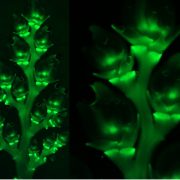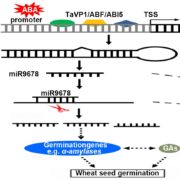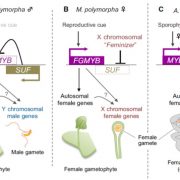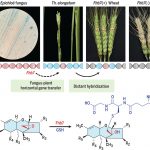Hungry bumblebees bite plants to accelerate flowering (Science)
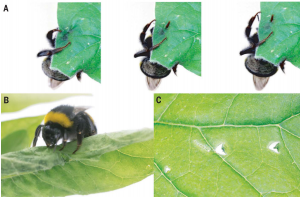 Bumblebees receive nutrition from flowers in exchange for aiding plant fertilization. This mutualistic relationship relies on timely availability of flowers for the pollinators, but annual variation in flowering time in changing environments can pose a challenge. Pashalidou and Lambert et al. now found that bumblebees can actively control the flowering of plants. The authors observed that commercial bumblebee (Bombus terrestris) workers use their mandibles and tongue to nibble holes in plant leaves. Laboratory experiments showed that bee-damaged plants bear flowers about 25-30 days earlier than undamaged or mechanically damaged plants, and the damaging behavior of B. terrestris is strongly induced when pollen availability is limited. The latter observation was confirmed by semi-natural experiments conducted over two years. Two wild bumblebee species also showed leaf damaging behavior stimulated by low pollen availability, suggesting the behavior may be widespread. These findings suggest that damaging plant leaves when floral resources run short might be an adaptive trait for bumblebees to accelerate flowering. This study opens many questions, including ones important for basic plant biology: 1) “how do plants accelerate flowering upon leaf damage caused by bumblebees?”, 2) “is this an adaptive strategy for plants to increase the chance for pollination?”, and 3) “how have such mechanisms co-evolved?” (Summary by Tatsuya Nobori @nobolly) Science 10.1126/science.aay0496
Bumblebees receive nutrition from flowers in exchange for aiding plant fertilization. This mutualistic relationship relies on timely availability of flowers for the pollinators, but annual variation in flowering time in changing environments can pose a challenge. Pashalidou and Lambert et al. now found that bumblebees can actively control the flowering of plants. The authors observed that commercial bumblebee (Bombus terrestris) workers use their mandibles and tongue to nibble holes in plant leaves. Laboratory experiments showed that bee-damaged plants bear flowers about 25-30 days earlier than undamaged or mechanically damaged plants, and the damaging behavior of B. terrestris is strongly induced when pollen availability is limited. The latter observation was confirmed by semi-natural experiments conducted over two years. Two wild bumblebee species also showed leaf damaging behavior stimulated by low pollen availability, suggesting the behavior may be widespread. These findings suggest that damaging plant leaves when floral resources run short might be an adaptive trait for bumblebees to accelerate flowering. This study opens many questions, including ones important for basic plant biology: 1) “how do plants accelerate flowering upon leaf damage caused by bumblebees?”, 2) “is this an adaptive strategy for plants to increase the chance for pollination?”, and 3) “how have such mechanisms co-evolved?” (Summary by Tatsuya Nobori @nobolly) Science 10.1126/science.aay0496
[altmetric doi=”10.1126/science.aay0496″ details=”right” float=”right”]



